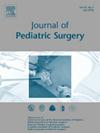肋间神经冷冻消融术在胸大肌微创修复术中的应用:全国趋势、结果和使用预测因素
IF 2.4
2区 医学
Q1 PEDIATRICS
引用次数: 0
摘要
目的 在胸廓外翻微创修复术(MIRPE)中进行肋间神经冷冻消融是一种有效的疼痛控制技术。一些保险公司可能不会报销冷冻消融术的费用,认为这是一种实验性手术。本研究旨在描述全国冷冻消融术的使用趋势,并评估其使用结果和预测因素。方法在儿科健康信息系统数据库中查询了在 2016 年至 2023 年期间接受 MIRPE 的 9-21 岁乳突患者。通过账单/供应代码确定了冷冻消融的同时使用情况。使用线性回归对冷冻消融使用的时间趋势进行了描述和量化。使用卡方检验和 Kruskal-Wallis 检验比较了冷冻消融患者的人口统计学特征、资源利用率和结果。结果该分析包括 2068 名患者(平均年龄为 15 ± 1.8 岁;86% 为男性)。从 2016 年到 2023 年,冷冻消融术的使用率从 33% 增加到 61%,并呈现出强烈的正向趋势(R2 = 0.73)。冷冻消融患者的手术并发症较少(8 % vs. 12 %,p = 0.004),住院时间较短(2.0 ± 1.3 vs. 2.8 ± 1.6 天,p < 0.001),鸦片类药物的总平均结算天数较少(1.4 ± 1.1 vs. 1.6 ± 1.4 天,p < 0.0001),总费用较高(24,045 美元 ± 9696 美元 vs. 20,751 美元 ± 9,237 美元,p < 0.001)。高容量中心(几率比(OR)1.9,95 % 置信区间(CI)1.2-3.0)和商业 HMO 保险(OR 2.7,95 % CI 1.9-3.8)是使用冷冻消融的预测因素。冷冻消融应被视为 MIRPE 的标准辅助手段,而非实验性技术。本文章由计算机程序翻译,如有差异,请以英文原文为准。
Intercostal Nerve Cryoablation in Minimally Invasive Repair of Pectus Excavatum: National Trends, Outcomes, and Predictors of Utilization
Purpose
Intercostal nerve cryoablation during minimally invasive repair of pectus excavatum (MIRPE) is an effective pain control technique. Some insurers may not reimburse for cryoablation in this context, contending that it’s an experimental procedure. This study aimed to describe national trends in cryoablation use and evaluate outcomes and predictors of its use.
Methods
The Pediatric Health Information System database was queried for pectus excavatum patients aged 9–21 who underwent MIRPE between 2016 and 2023. Concurrent cryoablation use was identified using billing/supply codes. Temporal trends in cryoablation utilization were described and quantified using linear regression. Demographics, resource utilization, and outcomes were compared for patients based on cryoablation utilization using chi-square and Kruskal–Wallis tests. Predictors of cryoablation use were evaluated with logistic regression.
Results
This analysis included 2068 patients (mean age 15 ± 1.8 years; 86 % male). Cryoablation utilization increased from 33 % to 61 % from 2016 to 2023, with a strong positive trend (R2 = 0.73). Cryoablation patients had fewer surgical complications (8 % vs 12 %, p = 0.004), shorter LOS (2.0 ± 1.3 vs. 2.8 ± 1.6 days, p < 0.001), fewer total mean opiate days billed (1.4 ± 1.1 vs. 1.6 ± 1.4 days, p < 0.0001) and higher total costs ($24,045 ± $9696 vs. $20,751 ± $9,237, p < 0.001). High-volume centers (odds ratio (OR) 1.9, 95 % confidence interval (CI) 1.2–3.0) and commercial HMO insurance (OR 2.7, 95 % CI 1.9–3.8) were predictors of cryoablation use.
Conclusion
Cryoablation during MIRPE has increased nationally since 2016; now being performed in nearly two-thirds of all cases. Cryoablation should be considered a standard adjunct to MIRPE rather than an experimental technique.
Level of evidence
2.
求助全文
通过发布文献求助,成功后即可免费获取论文全文。
去求助
来源期刊
CiteScore
1.10
自引率
12.50%
发文量
569
审稿时长
38 days
期刊介绍:
The journal presents original contributions as well as a complete international abstracts section and other special departments to provide the most current source of information and references in pediatric surgery. The journal is based on the need to improve the surgical care of infants and children, not only through advances in physiology, pathology and surgical techniques, but also by attention to the unique emotional and physical needs of the young patient.

 求助内容:
求助内容: 应助结果提醒方式:
应助结果提醒方式:


